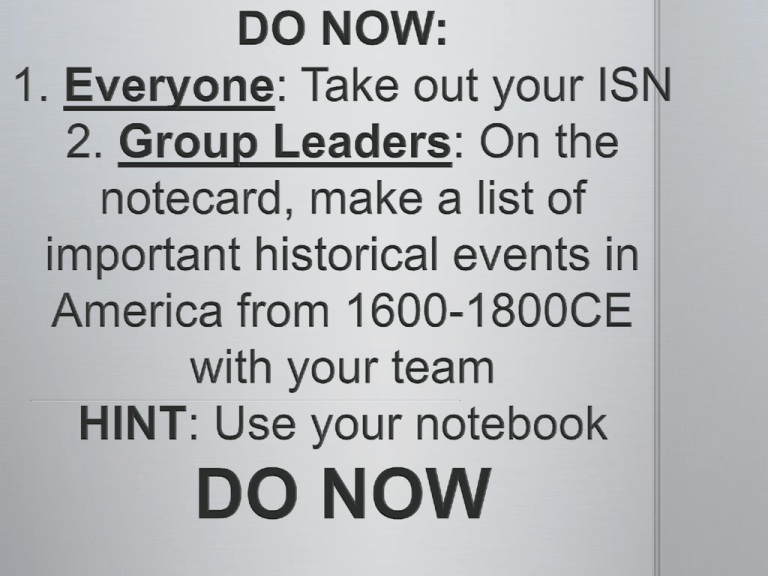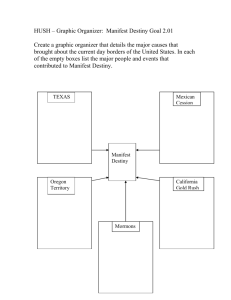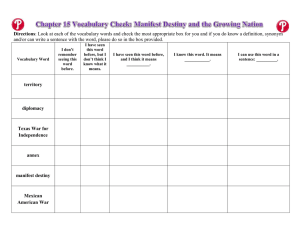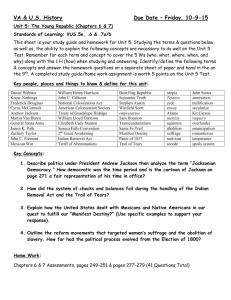WEstWard Expansion - Updated Mar. 17 - Mr. Abel
advertisement

Salsa Verde Cooperative Skill of the Week Homework People who need to stay in Content: Create a timeline Create a population growth graph Look at a map Language: Predict what will happen in the United States Create a timeline with your team with the following events The events in the timeline can help you predict what we will study next 1607: First permanent English colony of Jamestown 1754-1763: French and Indian War 1763-1775: British govt passes numerous laws restricting the colonies including Proclamation of 1763, Stamp Act, Coercive (Intolerable) Acts, Quartering Acts, Townshend Acts, and Tea Act. 1776: A group of wealthy colonists write and sign the Declaration of Independence creating a new country known as the United States of America 1776-1781: Revolutionary War 1787-1788: Constitution written, signed, and adopted creating the Federal Government of the United States In teams, make a graph and plot the data points to reveal your next clue HINT: only plot the points that are on the fiftieth and hundredth year – for example 1600, 1650, 1700, and not 1610, 1670, or 1720 Year Population Year Population 1650 50,400 1810 7,239,881 1670 111,900 1820 9,638,453 1690 210,400 1830 12,866,020 1700 250,900 1840 17,069,453 1720 466,200 1850 23,191,876 1740 905,600 1860 31,443,321 1750 1,170,800 1870 38,558,371 1770 2,148,100 1880 50,189,209 1790 3,929,214 1890 62,979,766 1800 5,308,483 1900 76,212,168 Year Population Year Population 1650 50,400 1810 7,239,881 1670 111,900 1820 9,638,453 1690 210,400 1830 12,866,020 1700 250,900 1840 17,069,453 1720 466,200 1850 23,191,876 1740 905,600 1860 31,443,321 1750 1,170,800 1870 38,558,371 1770 2,148,100 1880 50,189,209 1790 3,929,214 1890 62,979,766 1800 5,308,483 1900 76,212,168 What does the graph look like? What shape curve? In teams, analyze the map Write down 5 things that your team things are important to understand about the map Whatever seems important What countries claim territory in what is currently the United States? Whose claims are not on this map? Why do you think they are miss What does the timeline, graph, and map tell us about the United States? What can we predict about the future of the United States? How do you think the United States acquire the land it owns today? Salsa Verde Cooperative Skill of the Week Homework Finish out immigration unit Content: I will write the Essential Questions for the unit I will analyze an historical image I will define and interpret the meaning of Manifest Destiny Language: I will discuss the importance of a piece of historical art and how it is demonstrated in the details of the artwork How do nations gain territory? How did America’s belief in “from sea to shining sea” and Manifest Destiny impact westward expansion? What did this belief mean for the indigenous population? Whose belief was this? What motivated their desires to expand westward? Who gained from these beliefs? Who lost? Written responses to the Essential Questions Multiple Choice questions demonstrating understanding territorial expansion Comprehend and define the concept of Manifest Destiny as it relates to Western Expansion Know the ways the US gained new territories Understand the consequences for Native Americans with regard to policies of Indian Removal Write lyrics to a song that explains Westward Expansion ADVANCED OBJECTIVES: Be able to recognize biases and perspectives of events Be able to provide historical context when creating a historical argument In order to understand and ease modern day tensions between groups in the United States, it is necessary to understand the history of that relationship. If we want to empower ourselves to assist in creating a more equal, understanding, caring, and just society, understanding the history of how the United States gained territory is essential. What do you see? Make a list Based on your “what do you see?” list, what do you think is happening? Give the artwork a title What does “Manifest Destiny” mean? What does “obvious fate” mean? For what Americans was Manifest Destiny meant? What biases might John O’Sullivan have with regard to his idea of Manifest Destiny? Who does John O’Sullivan claim intended the continent to be meant for Americans? What do you think about that? What problems with O’Sullivan’s claim are there? What do some call it when a person claims to know God’s plans? What might happen to some people when other’s believe God wants them to take over all the land (Manifest Destiny)? What does Manifest Destiny mean? Advanced Question: Why could Manifest Destiny be dangerous? Salsa Verde Cooperative Skill of the Week Homework Content: I will review Manifest Destiny I will read about territorial acquisition of the United States I will determine main ideas from the text I will critically think about and discuss language in the text Language: I will summarize how the United States gained territories Read first two sections on p. 198 Why did the United States want New Orleans? Why did Napoleon want the Louisiana Territory? Why did that worry American farmers? ISN: page 104 – Complete choices part Read “A Noble Bargain” on page 198-199 When/How did the U.S. obtain the Louisiana Territory? Read last section in teams on p. 199 Discuss these questions in teams: If an action is unconstitutional, but really seems to be best for the country, is it okay for the president to do it? Why or why not? Summarize how the United States obtained the territory of Louisiana, and why it was an important acquisition. The Background: Take notes on the background information before the U.S. acquired the territory The Choices/Activity: Go over the possible choices that the United States has – and make your choice The Result: What happened? When/How did the United States acquire the territory? The Critical Discussion: Was power, authority, or both used to acquire the land? Why do you think so? Other questions that would be critical, or question, the decisions of the United States. The Summary: A final question for sum up the information learned from your presentation. The team will teach the rest of the class the section they read You will use your notes and the document camera You will read the sections with the class You will give them the 3 choices for what they think the United States should do You will lead a discussion around the question of power and authority You will one one day to complete the work for your presentation Salsa Verde Cooperative Skill of the Week Homework Content: I will read about territorial acquisition of the United States I will determine main ideas from the text I will critically think about and discuss language in the text Language: I will summarize how the United States gained territories The Background: Take notes on the background information before the U.S. acquired the territory The Choices/Activity: Go over the possible choices that the United States has – and make your choice The Result: What happened? When/How did the United States acquire the territory? The Critical Discussion: Was power, authority, or both used to acquire the land? Why do you think so? Other questions that would be critical, or question, the decisions of the United States. The Summary: A final question for sum up the information learned from your presentation. The team will teach the rest of the class the section they read You will use your notes and the document camera You will read the sections with the class You will give them the 3 choices for what they think the United States should do You will lead a discussion around the question of power and authority You will one one day to complete the work for your presentation Salsa Verde Cooperative Skill of the Week Homework Content: I will read and take notes about territorial acquisition of the United States I will critically think about a text I will present information for the rest of the class Language: I will discuss language used in the text with regard to land acquisition Background Acquisition Power, Authority, or both Summary Background Acquisition Power, Authority, or both Summary Background Acquisition Power, Authority, or both Summary Background Acquisition Power, Authority, or both Summary Content: I will define counter-text I will read and answer questions about the acquisition of Florida I will create questions about the acquisition of Florida Language: I will discuss the differences in two texts discussing the same events I will reflect and write what perspective means in the dissemination of knowledge 1: Questions 2. Answers from Reading 1 3. Answers from Reading 2 Florida from Manifest Destiny and the Growing Nation – page 200 What is the purpose of the introduction of the section? How do you know? To present the problems What are the problems? How do you know? Runaway Slaves; Seminal Indian Raids What aren’t the problems? How do you know? People being enslaved; knowing why Seminole Indians are raiding Georgia farmers What is the purpose of the section Andrew Jackson Invades Florida? How do you know? To explain how Andrew Jackson took over Florida What did Jackson do according to History Alive? How do you know? Disobeyed orders from the President of the United States Illegally attacked a foreign nation Illegally arrested, tried, and executed two British citizens Illegally replaced the head of government in a foreign nation How does History Alive talk about Andrew Jackson’s crimes? What is Spain’s perspective? How do you know? How does the British government feel about the execution of two of their citizens? How do leaders of the Seminole Nation feel about the invasion? What are runaway slaves saying about the invasion? Why don’t you know? What is the purpose of the section “Govern or Get Out”? How do you know? To explain how the United States acquired Florida What was the perspective of James Monroe? How do you know? Why did Monroe’s perspective change? How do you know? What was Spain’s perspective? How do you know? What don’t we know about Spain’s perspective? What was the final result according to History What questions are you left with after reading the section about the acquisition of Florida? Why do you have those questions? If you don’t have any questions, explain why you do not have any questions What do you think a counter-text is? A text that refutes or adds information A text that provides a different perspective of an event or series of events Excerpt From: As Long As Grass Grows Or Water Runs By Howard Zinn Chapter from A People’s History of the United States Howard Zinn is a historian who is critical of those with power. He prefers to tell history from the perspective of the powerless. Read and answer quesitons Which account about the acquisition of Florida was better? Why? How can we make sense of what we learned from both these texts? What does it mean for us as citizens in a democracy to know that the presentation of knowledge can be so different? Why is it important to consider the biases and perspective of an author when information is presented to us? Why is it important to consider biases and perspective when information is presented to us? Read first three sections Take notes on first three sections Think about what you think the US should do – Sell Oregon to Great Britain; Take it all and risk war; or, split the land with Britain Read last section and take notes Write whether Power, Authority or both were used to acquire Oregon AND say why you think so Write a summary of the section Content: To read and take notes about territorial acquisition of the United States Critically think about a text Give a presentation for the rest of the class Language: Discuss power and authority with regard to land acquisition Salsa Verde Cooperative Skill of the Week People who did not do homework Homework Challenge This week’s homework Test tomorrow on the acquisition of territories GOLD Content: To read and take notes about territorial acquisition of the United States Critically think about a text Give a presentation for the rest of the class Language: Discuss power and authority with regard to land acquisition Background Acquisition Power, Authority, or both Summary Background Acquisition Power, Authority, or both Summary People who did not do homework PJ day Silly hat day Multiple Choice Questions: Read the entire question Read all answer choices Cross out answers you know are wrong Select the best answer that remains Other questions: Read and follow all directions There must be silence until all tests are collected Content: To review questions from the test Language: Write complete sentences Put your name at the top 1. D 2. B 3. C 4. D 5. A 6. B 7. D 8. A 9. A 10. B 11. A 12. D 13. C 14. B 15. B 16. C 17. B 18. A 19. C 20. B No talking – Ask me questions Multiple Choice Strategy 1. Read the entire prompt/question 2. Read all the answers 3. Cross out any answers you know are wrong 4. Select the best answer from the remaining questions When you are finished – work on the homework due tomorrow Assessment Read Documents J, K, L, and M Complete Graphic Organizer for those documents To voice ideas and opinions with regard to historical perspective To identify and discuss inconsistencies in Historical Texts If you have a question or comment, indicate to whomever is speaking by raising your hand Not more than one person talking at once Everyone is listening To get an idea of how Native Americans were treated in the West as Americans began moving westward Read through the documents on Andrew Jackson Extract information with regard to his status as a hero or not 1. D 2. B 3. C 4. D 5. A 6. B 7. D 8. A 9. A 10. B 11. A 12. D 13. C 14. B 15. B 16. C 17. B 18. A 19. C 20. B A document written about an event during the time period of the event. A document written about an event after an event occurred Look at the sources in the packet Which ones are primary and which are secondary? Is History Alive primary or secondary? Is Howard Zinn primary or secondary? Edward Everett’s Letter to Congress To review all the documents that we have read; thus far Homework for this week What is a primary and secondary source? Who is the essay about? What is the question you are answering for the essay? Why do you think we are doing this? J, K, L, M, Everett Speech, Speckled Snake, History Alive 14.2; History Alive 14.3; HA 14.4; HA 14.5; HA 14.6; HA 14.7 (pages start at 186) 1. On your own, read the document 2. Review your notes from that reading 3. Add anything new you have learned to your notes (remember to underline/highlight where you found it – for HA write the section and paragraph number) Find a partner who has the same document Title the paper with the name of your document/reading Write whether it is a primary or secondary source Write a sentence stating the main idea of the document Create a T-Chart; title the left: Should be on the $20 bill; title the right: Should not be on the $20 bill Write the reasons you and your partner have, and write where the are located in the document (page and paragraph #) Document J: Andrew Jackson’s Message to Congress Primary Source The main idea Andrew Jackson’s message to Congress is that he wants Congress to set aside land for Native Americans in the Southeastern states to move to. Evidence of should Evidence of should not -Native American tribes -AJ does not mention are in danger and AJ wants what Nat. Am.’s want them to survive by giving (no where in doc) them land out West (Paragraph 2) --He says they can stay if they want (Paragraph 1) -He cares about Nat. Am. survival (Paragraph 1) K (description): Evidence of should should not Evidence of L (description): Evidence of should should not Evidence of M (description): Evidence of should should not Evidence of Everett Speech to Congress (description): Evidence of should should not Evidence of Speckled Snake Statement (description): Evidence of should should not Evidence of Second Annual Address (description): Evidence of should should not Evidence of History Alive Part 1(description): Evidence of should should not Evidence of History Alive Part 2 (description): Evidence of should should not Evidence of Field Trip Homework due tomorrow Reading 1, 2, and 3 from Andrew Jackson packet To review the History Alive sections for our essay on Andrew Jackson Read the section that will be gone over Write the introductory paragraph for the Andrew Jackson essay HOMEWORK: Completed introductory paragraph, and an essay plan



